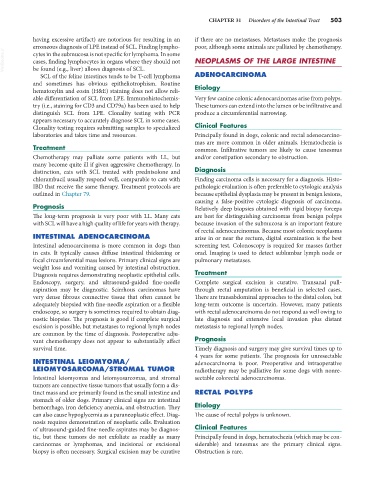Page 531 - Small Animal Internal Medicine, 6th Edition
P. 531
CHAPTER 31 Disorders of the Intestinal Tract 503
having excessive artifact) are notorious for resulting in an if there are no metastases. Metastases make the prognosis
erroneous diagnosis of LPE instead of SCL. Finding lympho- poor, although some animals are palliated by chemotherapy.
VetBooks.ir cytes in the submucosa is not specific for lymphoma. In some NEOPLASMS OF THE LARGE INTESTINE
cases, finding lymphocytes in organs where they should not
be found (e.g., liver) allows diagnosis of SCL.
SCL of the feline intestines tends to be T-cell lymphoma ADENOCARCINOMA
and sometimes has obvious epitheliotrophism. Routine Etiology
hematoxylin and eosin (H&E) staining does not allow reli-
able differentiation of SCL from LPE. Immunohistochemis- Very few canine colonic adenocarcinomas arise from polyps.
try (i.e., staining for CD3 and CD79a) has been used to help These tumors can extend into the lumen or be infiltrative and
distinguish SCL from LPE. Clonality testing with PCR produce a circumferential narrowing.
appears necessary to accurately diagnose SCL in some cases.
Clonality testing requires submitting samples to specialized Clinical Features
laboratories and takes time and resources. Principally found in dogs, colonic and rectal adenocarcino-
mas are more common in older animals. Hematochezia is
Treatment common. Infiltrative tumors are likely to cause tenesmus
Chemotherapy may palliate some patients with LL, but and/or constipation secondary to obstruction.
many become quite ill if given aggressive chemotherapy. In
distinction, cats with SCL treated with prednisolone and Diagnosis
chlorambucil usually respond well, comparable to cats with Finding carcinoma cells is necessary for a diagnosis. Histo-
IBD that receive the same therapy. Treatment protocols are pathologic evaluation is often preferable to cytologic analysis
outlined in Chapter 79. because epithelial dysplasia may be present in benign lesions,
causing a false-positive cytologic diagnosis of carcinoma.
Prognosis Relatively deep biopsies obtained with rigid biopsy forceps
The long-term prognosis is very poor with LL. Many cats are best for distinguishing carcinomas from benign polyps
with SCL will have a high quality of life for years with therapy. because invasion of the submucosa is an important feature
of rectal adenocarcinomas. Because most colonic neoplasms
INTESTINAL ADENOCARCINOMA arise in or near the rectum, digital examination is the best
Intestinal adenocarcinoma is more common in dogs than screening test. Colonoscopy is required for masses farther
in cats. It typically causes diffuse intestinal thickening or orad. Imaging is used to detect sublumbar lymph node or
focal circumferential mass lesions. Primary clinical signs are pulmonary metastases.
weight loss and vomiting caused by intestinal obstruction.
Diagnosis requires demonstrating neoplastic epithelial cells. Treatment
Endoscopy, surgery, and ultrasound-guided fine-needle Complete surgical excision is curative. Transanal pull-
aspiration may be diagnostic. Scirrhous carcinomas have through rectal amputation is beneficial in selected cases.
very dense fibrous connective tissue that often cannot be There are transabdominal approaches to the distal colon, but
adequately biopsied with fine-needle aspiration or a flexible long-term outcome is uncertain. However, many patients
endoscope, so surgery is sometimes required to obtain diag- with rectal adenocarcinoma do not respond as well owing to
nostic biopsies. The prognosis is good if complete surgical late diagnosis and extensive local invasion plus distant
excision is possible, but metastases to regional lymph nodes metastasis to regional lymph nodes.
are common by the time of diagnosis. Postoperative adju-
vant chemotherapy does not appear to substantially affect Prognosis
survival time. Timely diagnosis and surgery may give survival times up to
4 years for some patients. The prognosis for unresectable
INTESTINAL LEIOMYOMA/ adenocarcinoma is poor. Preoperative and intraoperative
LEIOMYOSARCOMA/STROMAL TUMOR radiotherapy may be palliative for some dogs with nonre-
Intestinal leiomyomas and leiomyosarcomas, and stromal sectable colorectal adenocarcinomas.
tumors are connective tissue tumors that usually form a dis-
tinct mass and are primarily found in the small intestine and RECTAL POLYPS
stomach of older dogs. Primary clinical signs are intestinal
hemorrhage, iron deficiency anemia, and obstruction. They Etiology
can also cause hypoglycemia as a paraneoplastic effect. Diag- The cause of rectal polyps is unknown.
nosis requires demonstration of neoplastic cells. Evaluation
of ultrasound-guided fine-needle aspirates may be diagnos- Clinical Features
tic, but these tumors do not exfoliate as readily as many Principally found in dogs, hematochezia (which may be con-
carcinomas or lymphomas, and incisional or excisional siderable) and tenesmus are the primary clinical signs.
biopsy is often necessary. Surgical excision may be curative Obstruction is rare.

